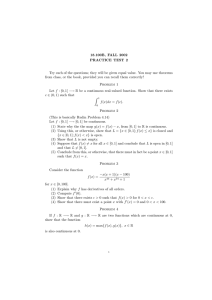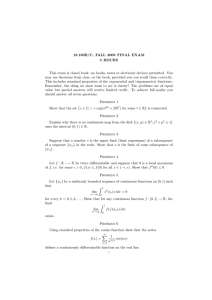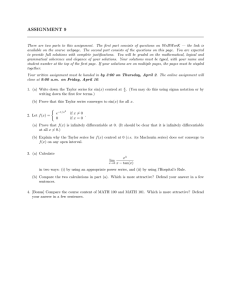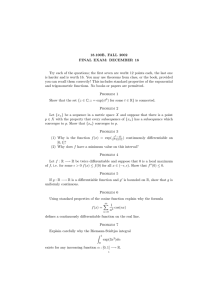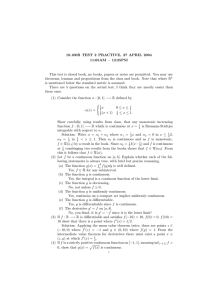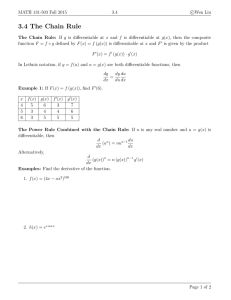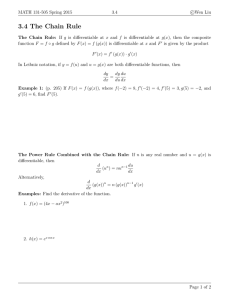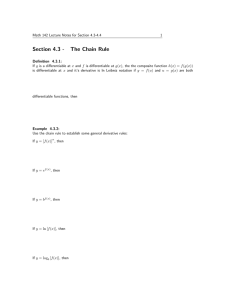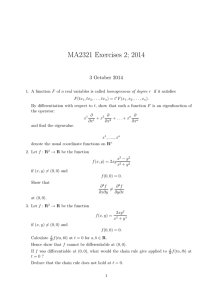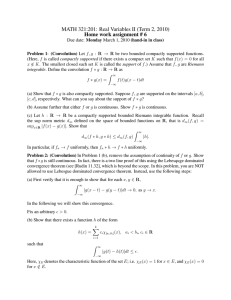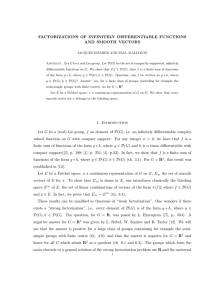18.100B, FALL 2002 PRACTICE TEST 2
advertisement
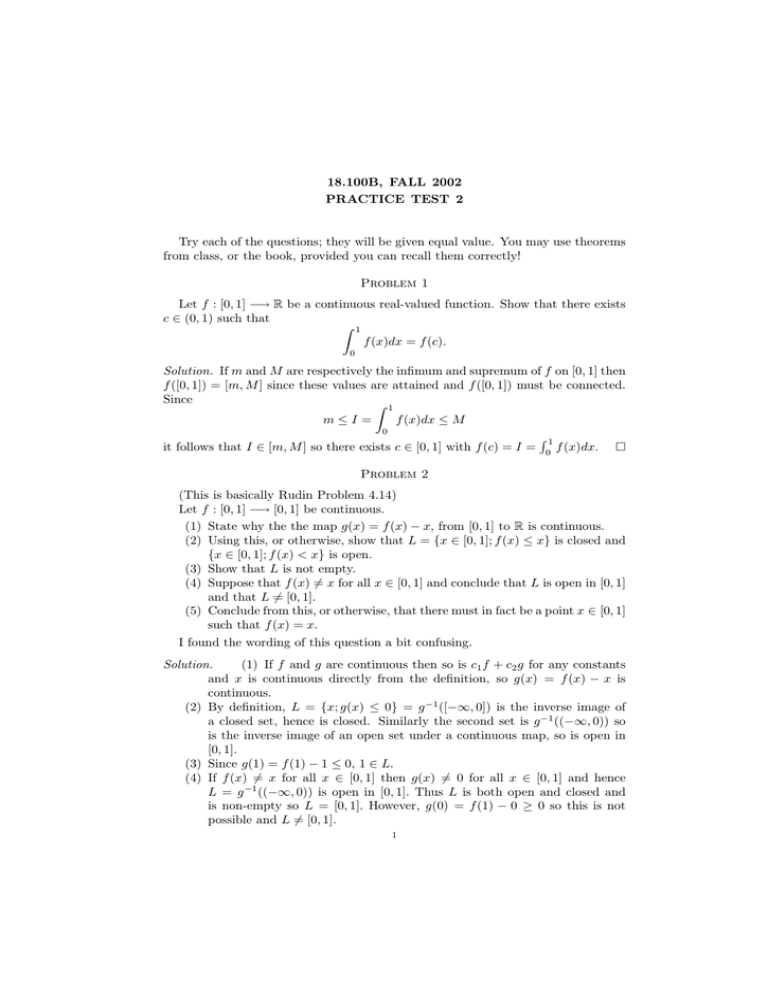
18.100B, FALL 2002
PRACTICE TEST 2
Try each of the questions; they will be given equal value. You may use theorems
from class, or the book, provided you can recall them correctly!
Problem 1
Let f : [0, 1] −→ R be a continuous real-valued function. Show that there exists
c ∈ (0, 1) such that
Z 1
f (x)dx = f (c).
0
Solution. If m and M are respectively the infimum and supremum of f on [0, 1] then
f ([0, 1]) = [m, M ] since these values are attained and f ([0, 1]) must be connected.
Since
Z
1
m≤I=
f (x)dx ≤ M
0
it follows that I ∈ [m, M ] so there exists c ∈ [0, 1] with f (c) = I =
R1
0
f (x)dx.
Problem 2
(This is basically Rudin Problem 4.14)
Let f : [0, 1] −→ [0, 1] be continuous.
(1) State why the the map g(x) = f (x) − x, from [0, 1] to R is continuous.
(2) Using this, or otherwise, show that L = {x ∈ [0, 1]; f (x) ≤ x} is closed and
{x ∈ [0, 1]; f (x) < x} is open.
(3) Show that L is not empty.
(4) Suppose that f (x) 6= x for all x ∈ [0, 1] and conclude that L is open in [0, 1]
and that L 6= [0, 1].
(5) Conclude from this, or otherwise, that there must in fact be a point x ∈ [0, 1]
such that f (x) = x.
I found the wording of this question a bit confusing.
Solution.
(1) If f and g are continuous then so is c1 f + c2 g for any constants
and x is continuous directly from the definition, so g(x) = f (x) − x is
continuous.
(2) By definition, L = {x; g(x) ≤ 0} = g −1 ([−∞, 0]) is the inverse image of
a closed set, hence is closed. Similarly the second set is g −1 ((−∞, 0)) so
is the inverse image of an open set under a continuous map, so is open in
[0, 1].
(3) Since g(1) = f (1) − 1 ≤ 0, 1 ∈ L.
(4) If f (x) 6= x for all x ∈ [0, 1] then g(x) 6= 0 for all x ∈ [0, 1] and hence
L = g −1 ((−∞, 0)) is open in [0, 1]. Thus L is both open and closed and
is non-empty so L = [0, 1]. However, g(0) = f (1) − 0 ≥ 0 so this is not
possible and L 6= [0, 1].
1
2
18.100B, FALL 2002 PRACTICE TEST 2
(5) Thus f (x) 6= x for all x ∈ [0, 1] is not possible, so there must exist a point
x ∈ [0, 1] with f (x) = x.
Problem 3
Consider the function
f (x) =
−x(x + 1)(x − 100)
x44 + x34 + 1
for x ∈ [0, 100].
(1) Explain why f has derivatives of all orders.
(2) Compute f 0 (0).
(3) Show that there exists > 0 such that f (x) > 0 for 0 < x < .
(4) Show that there must exist a point x with f 0 (x) = 0 and 0 < x < 100.
Solution.
(1) Polynomials are infinitely differentiable and the quotient p/q of
two infinitely differentiable functions is infinitely differentiable on any interval on which q 6= 0. Since x44 + x34 + 1 > 0 for x ∈ R it follows that
f = p/q is infinitely differentiable on R.
0
(0)q 0 (0)
and p(0) = 0, p0 (0) = 100, q(0) = 1, q 0 (0) =
(2) Since f 0 (0) = p (0)q(0)−f
q 2 (0)
0
0 it follows that f (0) = 100.
(3) Since f 0 (x) is continuous, there exists > 0 such that f 0 (x) > 0 if x ∈ [0, ).
By the mean valued theorem for x ∈ (0, ),
f (x) = xf 0 (y), y ∈ (0, ) =⇒ f (x) > 0.
(4) From the form of f, f (100) = 0 so, again by the mean value theorem
f (100) − f (0) = 0 = 100f 0 (x)
for some x ∈ (0, 100).
Problem 4
If f : R −→ R and g : R −→ R are two functions which are continuous at 0,
show that the function
h(x) = max{f (x), g(x)}, x ∈ R
is also continuous at 0.
Solution. Either h(0) = f (0) or h(0) = g(0) (or both). Since h is unchanged if we
exchange f and g we may assume that h(0) = f (0).
If g(0) 6= f (0) then g(0) < f (0). By the continuity of f and g, given > 0 there
exists δ1 > 0 and δ2 > 0 such that
|x| < δ1 =⇒ |f (x) − f (0)| < , |x| < δ2 =⇒ |g(x) − g(0)| < .
Taking δ = min(δ1 , δ2 ) and < 12 (f (0) − g(0)) gives both g(x) ≤ g(0) + 12 and
f (x) ≥ f (0) − 12 ≥ g(x) on (δ, δ) so h(x) = f (x) is continuous at 0.
On the other hand if g(0) = f (0) then taking δ = min(δ1 , δ2 ) means that
f (x), g(x) ∈ (h(0) − , h(0) + ) so |h(x) − h(0)| < and again the continuity
of h follows.
